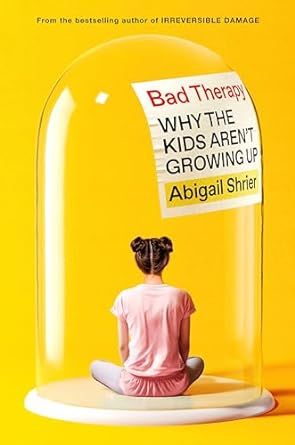Therapy
Is "Bad Therapy" Bad Therapy?
A review of Abigail Shrier's new book.
Posted April 9, 2024 Reviewed by Tyler Woods
Key points
- Abigail Shrier's new book was a huge bestseller, reaching #1 on Amazon.
- Shrier believes that almost all modern psychotherapy is worse than useless for the great majority of kids.
- She provides no guidance for determining who might benefit from psychotherapy and who would not.
- Elon Musk and Jordan Peterson loved her book, but "Bad Therapy" may do more harm than good.

Over the past 30 years, there has been a marked rise in the proportion of children and teens diagnosed with psychiatric disorders. How come? In her latest book, Bad Therapy: Why the Kids Aren’t Growing Up, journalist Abigail Shrier offers a novel explanation for the rise in psychiatric disorders among children and teens. According to Shrier, the upsurge in psychiatric diagnosis is due primarily to therapists practicing “bad therapy.”
Shrier considers most of modern psychotherapy to be “bad therapy”—hence the title—and “bad therapy encourages hyperfocus on one’s emotional states, which in turn makes symptoms worse” (p. 64). Even if your child doesn’t see a therapist, your child is still subject to bad therapy. “Far from confinement to the psychoanalyst’s couch,” Shrier writes, “bad therapy is today practiced on almost every kid—by therapists and just as often by non-therapists. The epicenter of bad therapy in your children’s life is, most likely, their school” (p. 65). Shrier then asserts that most teachers are now amateur psychotherapists. The only scholarly paper she cites in support of that remarkable assertion is a study I published more than 20 years ago, reporting a survey I did of physicians in and near Washington, D.C., in which I asked: Who first suggests the diagnosis of attention deficit hyperactivity disorder (ADHD)? The respondents to my survey reported that teachers were the most likely to be the first to suggest the diagnosis. But it’s a big leap to jump from that finding of mine to the claim that teachers are actually acting as therapists in the classroom.
In support of that leap, Shrier reports on a conference for public school teachers in Anaheim, California, which she attended. Teachers at the conference were instructed in “trauma-informed education,” learning to treat every child as a survivor of trauma. Shrier puts great weight on this conference, and on a few anecdotes from the classroom, to buttress her claim that teachers everywhere are now bringing “bad therapy” into the classroom. She writes: “A recent California bill, likely to pass, allocated $50 million for the hiring of additional squadrons of social workers and mental health professionals in public schools. Meaning, however much in-school therapy kids have already received, they likely will soon be getting much more.” (p 73)
Actually, that bill—California Assembly Bill 912—was vetoed by Governor Newsom on October 8, 2023, almost five months before the publication of Shrier’s book, but Shrier’s text was not corrected or updated.
Note also her claim that “however much in-school therapy kids have already received, they likely will soon be getting much more.” That claim should have been, “however much in-school therapy California kids have already received, California kids likely will soon be getting much more.” The bulk of the examples Shrier provides of teachers pushing kids to talk about their feelings come from California, where Shrier has lived for the past two decades. Shrier mentions California 25 times in her book. She gives no evidence of any effort to determine whether these practices are common, or practiced at all, in Texas, Minnesota, Michigan, Ohio, and many other states she never mentions. A more accurate title for her book might have been "Some Teachers in Southern California May Be Overstepping Their Bounds." But a book with that title would not have become a phenomenal bestseller.
In the very first line of her book, Shrier asserts that “Talk of a ‘youth mental health crisis’ often conflates two distinct groups of young people. One suffers from profound mental illness... They are not the subject of this book. This book is about a second, far larger cohort: the worriers; the fearful; the lonely, lost, and sad.” The foundational premise of Shrier’s book is that these two groups are easily distinguished. The second group—“the worriers; the fearful; the lonely, lost, and sad”—does not, in Shrier’s opinion, benefit from psychotherapy at all. Instead, she asserts that modern psychotherapy makes this “far larger cohort” worse rather than better. Shrier’s preferred intervention is to walk it off. Snap out of it. Don’t talk about your problems. Don’t even think about your problems. She writes:
How do you know whether to put your thirteen-year-old in therapy? Simple: don’t take your kid to a shrink unless you’ve exhausted all other options... In all but the most serious cases, your child is much better off without them... Adolescents who are suffering with anxiety and depression are obviously not being helped by the current and pervasive mental health treatments.
Reading Shrier’s book, I couldn’t stop thinking about Madison Holleran. As a high school student, Madison led the high school girls’ soccer team to two consecutive state championships. She also won the New Jersey state championship in the girls’ 800-meter. She was smart and successful, a top student as well as a top athlete. She enrolled at the University of Pennsylvania, but in her first semester at Penn she soon came to feel overwhelmed by the challenging coursework and the demands of being on the track team. She told a friend, “I never thought it was possible to sink so low, so fast.”
After five months at Penn, Madison Holleran committed suicide by jumping off the top floor of a parking garage. She had no previous psychiatric history. She had never seen a therapist or been on any psychiatric medication. After her death, her parents gave Madison’s phone, unlocked, and her computer, to reporter Kate Fagan. Fagan then spent months reviewing every text message, every Instagram post, interviewing every friend, every roommate, every teammate, to try to understand: why? Why would this beautiful, popular, bright, talented girl kill herself?
I would like to ask Shrier: What guidance would you provide to determine whether a girl is at risk of suicide or just needs to be told to walk it off? Because Bad Therapy provides no guidance in answer to this question. None. Madison Holleran was doing well in school. She had many friends; in fact, she was popular. There was no evidence that she suffered from any mental illness prior to her suicide. If her parents had read Shrier’s book, they would not have considered therapy for Madison, when, in fact, a careful reading of Fagan’s book What Made Maddy Run shows that Madison would have needed intensive therapy, medication, and possibly inpatient treatment to prevent her suicide.
Shrier is a former opinion columnist for the Wall Street Journal. A columnist doesn’t have to worry about being sued for malpractice. If a columnist writes something stupid or wrong, and somebody dies as a result, nobody’s going to sue. As a clinician, I operate in a different world. Suppose a parent consults me about a child who is “lonely, lost, and sad.” Let’s suppose I tell mom to encourage the child to walk it off, to tell her child not to think about her problems so much—Shrier’s advice. Let’s suppose that Mom follows my advice. One week later, the child commits suicide. I would be liable. My action met the four requirements for malpractice: 1) I had a duty of care, as a physician; 2) my advice constituted a dereliction of duty; 3) something bad happened; 4) my dereliction of duty was plausibly the proximate cause of the bad thing that happened. As a journalist, Shrier has no duty of care. She can write anything she pleases and no court will find Shrier liable if a child dies as a result of a parent following Shrier’s advice. As one legal expert observes, “The public does not have any enforceable legal right against the press when it receives untruthful and inaccurate information.”
The foundational assumption of Shrier’s book is that it’s easy to distinguish between kids who truly have problems and kids who don’t. That assumption is false. That’s the lesson of Madison Holleran’s suicide. On the contrary, as both a family doctor and a psychologist, I can tell you that this distinction is one of the highest-stakes calls I have to make. When a parent asks, “Do you think we need to be concerned? Should we seek professional help?” you’d better be absolutely sure you know what you’re talking about before you tell the parent, as Shrier would have us say to almost every child, “No, your child is better off without professional help.”
Yes, Bad Therapy has been boosted to the top of the bestseller lists by celebrities such as Elon Musk, Joe Rogan, and Jordan Peterson. But Bad Therapy is likely to confuse and mislead parents in need of help for their kids.




